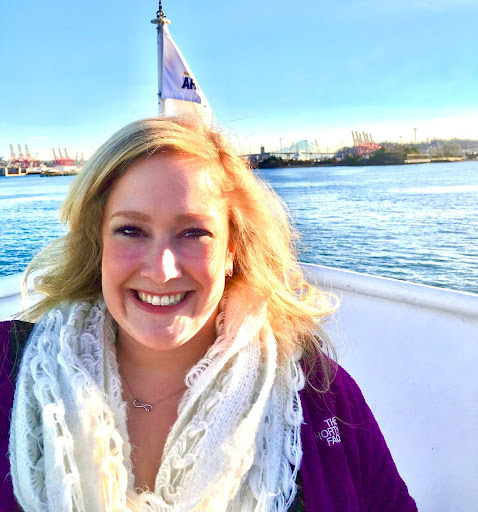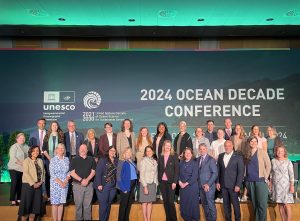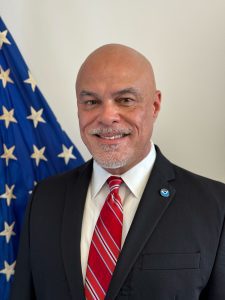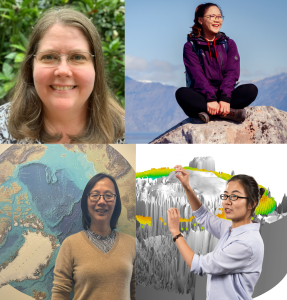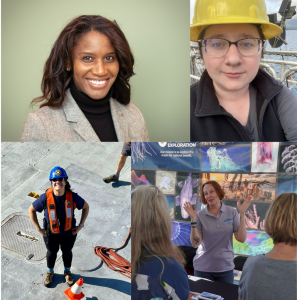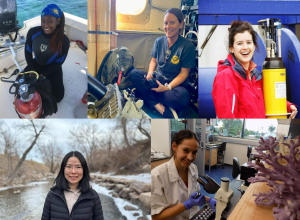To celebrate Women’s History Month, we asked women throughout NOAA Research who make lasting impacts in scientific research, leadership, and support from the field to the office to share how their work contributes to NOAA’s mission of Climate Resilience and preparing for a Climate-Ready Nation. This article highlights an interview with Dr. Samantha Wills, a research scientist at University of Washington Cooperative Institute for Climate, Ocean, and Ecosystem Studies (CICOES) and NOAA Pacific Marine Environmental Laboratory (PMEL). She works in the NOAA Ocean Climate Stations group led by Dr. Meghan Cronin, and uses novel Saildrone uncrewed surface vehicles to collect observations over remote regions of the tropical Pacific Ocean. These observations allow her to study mesoscale air-sea variability associated with atmospheric cold pool phenomena over the tropical ocean.
Our conversation follows:
What does climate resilience or climate-ready nation mean to you? What would you want people to know about NOAA’s work on climate resilience?
To me, the idea of a climate-ready nation is analogous to a user of a daily weather forecast. The purpose of that weather forecast is to provide a user with information that may alter their day-to-day decision making, such as adjusting a picnic due to impending rain, or packing an umbrella for the commute home. However, it is up to the user to decide whether or not to heed the forecast (which doesn't always pan out) and prepare themselves to handle an obstacle to their daily routine. In other words, the weather forecast gives the user a chance to get ahead of a potential problem, and not behind one.
And that is the crux of a climate-ready nation – utilizing the best available information to make informed decisions and prepare for future obstacles to the nation's well-being. Climate change is one such obstacle. NOAA's contribution to climate resilience is to provide the best possible information to address impacts due to climate change by supporting scientific research aimed at understanding Earth's complex climate system, which includes the atmosphere, land, ocean, ice, and living organisms.
What projects or research are you working on now, and how does your work contribute to climate resilience?
The ocean and atmosphere form a closely coupled system, and our ability to derive information from the ocean can help us to predict changes to climate and weather patterns across the globe, such as done for the El Nino Southern Oscillation. Unfortunately, compared to land, which only covers ~30% of the Earth's surface, observations over the ocean are few and far between. I have the rare advantage of working with an emerging technology, uncrewed surface vehicles, that has the potential to push ocean exploration to the next level. Our team is currently exploring the utility of this new technology and its potential for improving the Tropical Pacific Observing System. My research utilizes air-sea observations collected during field campaigns to remote (i.e., far from any landmass), under-sampled regions of the eastern tropical Pacific Ocean to better understand local scales of air-sea interaction and variability.
What do you enjoy most about your work?
I most enjoy working in public service. I believe that science is the pursuit of knowledge and truth, not profit, and I am glad that we push to make our research freely accessible and transparent. I hope that my contributions to the field will have a positive impact on society, and that is what drives me to keep pushing forward, even when the work gets frustrating.
What challenges have you faced as a woman in your career/field and how have you overcome them?
I recall a casual conversation I had with a professor during my time as an undergraduate. We were discussing opportunities post-graduation, such as my interest in attending graduate school in pursuit of a PhD. The professor made an off-handed comment (not maliciously) about how women tend not to get as far in graduate school because their family responsibilities will distract them or get in their way, and it felt as if he was preparing me for that inevitability; like I shouldn’t waste my time. Needless to say, I did not appreciate his insight. Instead, the experience only served to solidify my decision to pursue a doctorate while simultaneously fueling my fire to prove him (and anyone else who dared to doubt me) wrong. So I leaned on those, both professional and personal, who most supported me to achieve my dreams, and here I am now, Dr. Samantha Wills!
What drew you to your current career or field?
Well, the story goes that during my time in the womb, my mother endlessly consumed The Weather Channel, so she likes to take credit for my interest in weather and climate! But all jokes aside, I was exposed to severe weather from a young age growing up in Texas, with thunderstorms and tornadoes both terrifying and fascinating me. At school, math was my favorite subject, and as I contemplated college majors, I discovered that mathematics and meteorology go hand-in-hand. As for my journey to graduate school, I have to credit my faculty advisor Dr. Andrew Dessler at Texas A&M University. Given my aptitude for atmospheric science, he encouraged me to pursue a doctorate degree, which I had never considered. He guided me through the necessary steps (summer internships, coursework, GRE test, prospective advisors, etc.) to become a successful candidate, and he pointed out that regardless of the subject matter, I would gain valuable skills and toolsets to become a scientific researcher. Without the guidance and support I received from male and female mentors alike throughout my academic journey, I am not sure where I would be today.
Who do you look to as a role model and why?
I look to my advisor Dr. Meghan Cronin as a role model. She is a female scientist with an impressive career who has worked at NOAA for decades, and she is just a force to be reckoned with. The quality I most admire is her self-confidence. I'm not sure if it is a woman-thing or a me-thing, but I tend to downplay my successes and am quick to question my own abilities, especially as an early career scientist. But not Meghan. Meghan is a visionary who pushes our field forward, and she is not afraid to ruffle a feather or two to do so. Time after time, she has demonstrated how much she cares for me and our entire team at NOAA. I hope that one day I can pay forward all that Meghan has done to support me and my career.
Over the course of your career, what changes or progress have you seen for women in science and the workplace?
During my first year as a graduate student, I recall there were only two female professors working in my atmospheric science department, out of a group of 15-20 professors. But as time progressed, the department hired more female professors for tenure-track positions, and now the number of female professors has grown from two to eight! While progress takes time, the increased representation of female professors at my old department, all of whom are exceptional scientists, makes me believe that the institutions are listening and working to address inequality in the academic workforce.
Special thanks to Dr. Samantha Wills for participating in this interview for Women’s History Month at NOAA.
